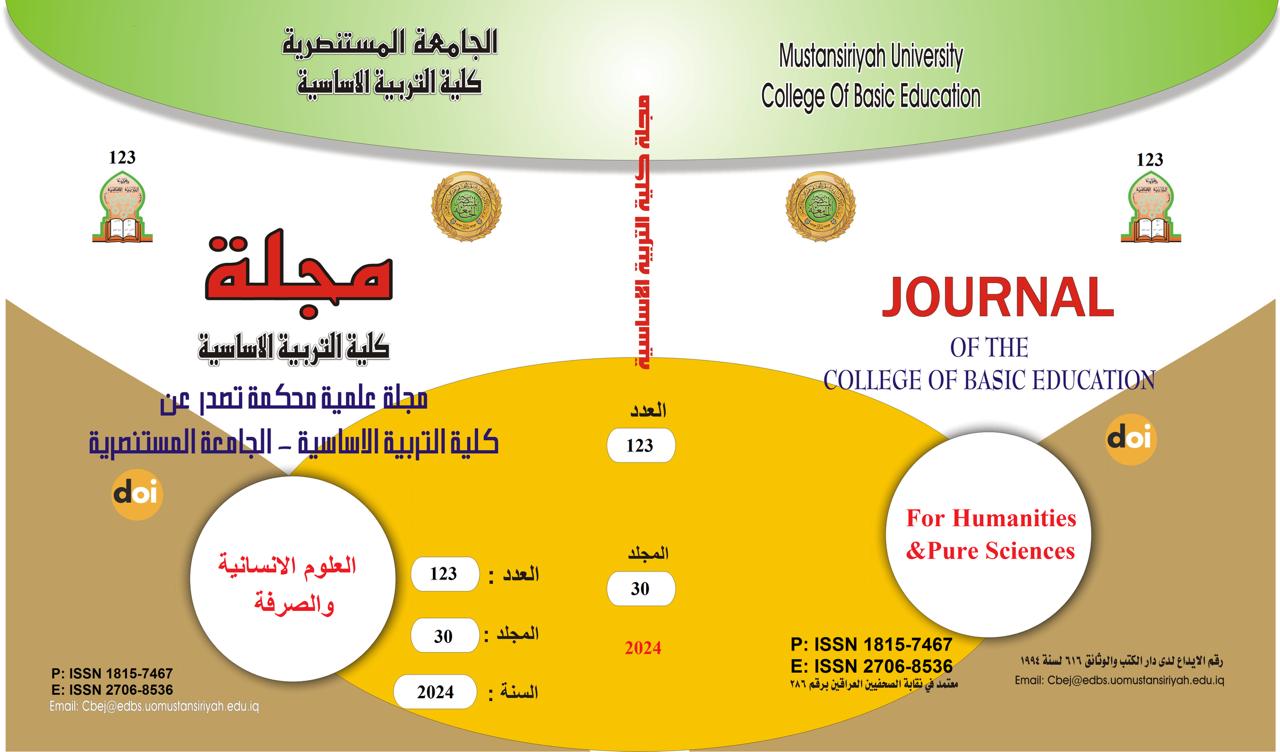The impact of the (model-Apply- preside- whispe (strategy on the achievement of second intermediate grade students and their preventive awareness
Main Article Content
Abstract
This research aims to identify the impact of the(model-Apply- preside- whispe) strategy the achievement of the second intermediate grade students in science and their preventive awareness; The following two zero hypotheses were derived from the objective:
- There is no statistically significant difference at the level of significance (0.05) between the average achievement scores of the students of the experimental group who will study using the strategy (model-Apply- preside- whispe) and the students of the control group who will study using the usual method of achievement.
- There is no statistically significant difference at the level of significance (0.05) between the average achievement scores of the students of the experimental group who will study using the strategy (model-Apply- preside- whispe) and the students of the control group who will study using the traditional method in the measure of preventive awareness of their dreams.
The experimental design was chosen with two experimental and control groups with a post-test for achievement and preventive awareness. The research community is represented by female secondary and middle school students for girls in the second province of Baghdad / Rusafa for the academic year (2022 AD - 2023 AD). 64 students were distributed into the two research groups, as the number of students in the experimental group was (32) students, and the number of students in the control group was (32) students.
Equivalence was conducted between the female students of the two research groups with the following variables: (chronological age calculated in months, parents’ academic achievement, previous information test, previous science achievement, Raven IQ test) in the first semester of the academic year (2022-2023 AD), as the researcher identified the subject The study that will be studied during the period of the experiment, which amounts to two chapters from the science book for the second intermediate grade, and formulated behavioral goals for the subjects that will be studied, so it was (131) behavioral goals according to Bloom’s levels (remembering, understanding, application, analysis, synthesis, and evaluation).
The researcher prepared daily teaching plans for science subjects that will be studied during the experiment, in the light of the content of the textbook and formulated behavioral goals, as they were prepared as follows:
- Preparing 16 model daily plans according to the (model-Apply- preside- whispe) strategy for the students of the experimental group.
- Preparing 16 model daily plans according to the usual method for the students of the control group.
A sample of it was presented to a group of arbitrators to see its validity and suitability for the students of the second intermediate grade, and to achieve the goal of the research, the researcher prepared two research tools, the achievement test: consisting of (35) objective paragraphs with four alternatives, and its apparent validity was extracted by presenting it to a group of arbitrators in Education and teaching methods, science, and also extracted the validity of the content in light of the test’s conformity to the content that was studied. The power of excellence, the difficulty coefficient, and the effectiveness of the wrong alternatives were calculated for each of the test items using the appropriate statistical means, and the stability was extracted using the Qodder Richardson-20 method, and it reached (0.87) And the preventive awareness test: It consists of three domains, which are (the cognitive, emotional, and skill domain), so that the test becomes in the initial format (48) items that include the cognitive and skill domains from (25) test items of the multiple-choice type, and includes the emotional domain from (23) test items of the type The specific answer is (yes, no), and Al-Dhaheri’s sincerity was extracted by presenting it to a group of arbitrators in education and methods of teaching science and psychology, and the discriminatory power and difficulty coefficient were calculated for each paragraph of the scale using appropriate statistical methods, and the stability was extracted by the half-partition method and the stability was extracted Between the two halves, the Pearson correlation coefficient was (0.82), and after correction by the Spearman-Brown equation, it reached (0.90(
The researcher applied the two research tools to the main sample after the end of the experiment period, and after analyzing the results statistically using the t-test for two independent samples (for the achievement test, the preventive awareness test). whisper) on the students of the control group who studied in the usual way in the achievement test and preventive awareness.
Based on the research results, the researcher concluded the following:
- Teaching the second intermediate grade students according to the strategy (model-dish-face-whisper) had a positive impact on raising the achievement of the students of the experimental group who studied according to the strategy (model-dish-face-whisper) compared to the achievement of the students of the control group who studied according to the method. regular.
- Teaching according to the strategy (model-Apply- preside- whispe) gives equal opportunities to the students through their positive participation in the activities of the lesson, while taking into account individual differences.
Accordingly, the researcher presented a number of recommendations and suggestions that were mentioned in the fourth chapter.
Article Details

This work is licensed under a Creative Commons Attribution-ShareAlike 4.0 International License.
